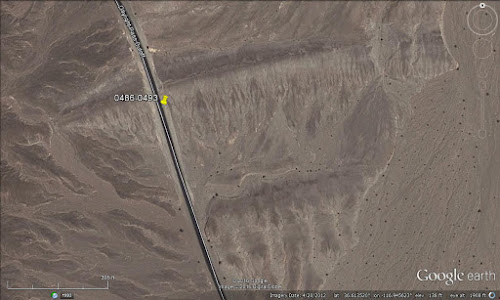It can be hard to drive by Walker Lake without stopping for photographs, though I find myself doing that more often than not. Sometimes the lighting is off, with the sun high in the sky or at the wrong angle, other times the lake and mountains are obscured by a pervasive haze. Consequently I have few good photos of the lake. I got lucky in the spring of 2008.
 |
| Between a rock and a guardrail: the steep eastern side of the Wassuk Range, looking north along Highway 95. |
 |
| Looking south toward Hawthorne from a pullout near what is now the north end of Walker Lake. |
 |
| A strangely stitched agglomeration of six photos. Notice the pronounced shorelines in the foreground and in the distance on the left. |
The first station we stopped at in Hawthorne was immediately frustrating for some reason, so I went to another station. The second station seemed to be still residing in the dark ages, without usable card readers, so I went inside. "Do you want to fill up? Leave your card here," the attendant said with her hand out. I looked at her like I'd never heard of such an archaic procedure, and she relented, "Go ahead, take it with you, just be sure to pay after." I filled up and went back in to pay. She apologized for the inconvenience, but I wasn't convinced that their card readers were actually broken. I thought it was at least 50-50 that the station was just trying to get customers inside to buy a drink or a snack or two. But maybe the out-of-order signs were legit...
For some reason I found the whole having-to-stop-in-Hawthorne situation just almost too much to handle, even though the city used to make you drive into town no matter what. Now there is a bypass. Then there was a great little Shell station at the downtown corner where you turned left after stopping at the town's single red light. It was a perfect opportunity to get excellent gas.
We pulled back onto the 4-lane part of Highway 95 near the west edge of Hawthorne and turned right onto the bypass.
Two things come to mind when I go through Hawthorne. First, I'll remember a dream I had once where I took the Hawthorne bypass and drove around town, north to south, and the bypass itself seemed to be the whole point of the dream. Second, after turning east onto Highway 95 at the south end of the bypass, my mind will go into a driving reverie and take me back to a time in the late 80s. I was telling someone that if I had enough money, I would quit my work in minerals exploration and just go out and map. Here or there. I'd seen a lot of places I thought were interesting, and I loved mapping. So, I'd just go out and map. And I'd start a map publishing company.
My unnamed sidekick said that mapping should have a point. Like I shouldn't just go out and map; maybe instead I should try to figure out something in particular about the geology of the area. I disagreed. The USGS mapped tons of quads and the whole point was getting the entire area (the West? the U.S.?) mapped. My mapping would be more detailed than quad mapping, and I would just go out and do it. Maybe I'd start right there—up ahead in the volcanic rocks near the pass outside of Luning. Maybe I'd start at any of several places I'd already done some detailed mapping, part of the point being to make the mapping available to the general population of geologists working in the area, not just to one exploration company.
 |
| Volcanic rocks in the Benton Spring area of the Gabbs Valley Range, about 7 miles north of Luning. |
MOH and I drove into Luning, and rather than stop at the Luning Rest Area, we took a dirt road going toward the hills of Black Dyke Mountain, accidentally choosing a road that would have eventually delivered us to the Blue Ribbon Mine. It was in this area that I learned how to test for the presence of copper in black Mn-oxides by using cold, dilute HCl to plate copper onto a rock hammer. This method tests for copper wad or neotocite (a hydrated Mn-silicate sometimes containing enough Cu to be considered an ore mineral), or a few other black copper minerals such as chalcocite and tenorite.
Not too far ahead, in the low hills of Black Dyke Mountain, we spotted some folds in unknown rock formations:
 |
| Folded, contorted rocks in the hills less than 2 miles SW of Luning. |
 |
| Zooming in on the folds. |
Related Posts (in order of posting):
Death Valley, "Super" Blooms, Turtlebacks, and Detachments
Death Valley Trip, Part 2: More of the Badwater Turtleback Fault
Death Valley Trip, Part 3: Northward, and over Daylight Pass
Death Valley Trip, Getting There: Wave Clouds beyond the Sierra
Death Valley Trip, Getting There: A Hike to Pleistocene Shorelines
























































